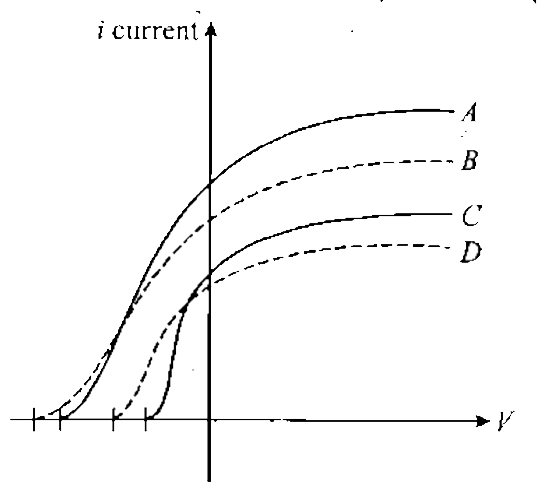Suppose the potential energy between an electron and a proton at a distance is given by . Application of Bohr's theory tohydrogen atom in this case showns thatSolution in Gujrati
energy in the ornits is proportional to
energy is proportional to (m = mass of electron)
energy in the nth orbit is proportional to
energy is proportional to (mass of electron)
The correct Answer is:A, B
(constant), Also
then total enegy
Topper's Solved these Questions
- SIMPLE HARMONIC MOTIONBOOK - ALLEN CHAPTER - SIMPLE HARMONIC MOTIONEXERCISE - Exercise - 07
2 Videos
- SIMPLE HARMONIC MOTIONBOOK - ALLEN CHAPTER - SIMPLE HARMONIC MOTIONEXERCISE - Exercise - 08
2 Videos
- SIMPLE HARMONIC MOTIONBOOK - ALLEN CHAPTER - SIMPLE HARMONIC MOTIONEXERCISE - Exercise - 05
2 Videos
- RACEBOOK - ALLEN CHAPTER - RACEEXERCISE - Basic Maths (Wave Motion & Dopplers Effect) (Stationary waves & doppler effect, beats)
25 Videos
- TEST PAPERBOOK - ALLEN CHAPTER - TEST PAPEREXERCISE - PHYSICS
4 Videos
Similar Questions
The stopping potential for the photo-electrons emitted from a metal surface of work-function 1.7 eV is 10.4 eV. Find the wavelength of the radiation used. Also identify the energy-levels in hydrogen atom which will emit this wavelength.
View SolutionThe figure shows the results of an experiment involving photoelectric effect. The graphs A, B,C and D relate to a light beam having different wavelengths. Select the correct alternative.

View SolutionWhen a hydrogen atom is excited from ground state to first excited state then
View SolutionThe frequency of a radar is 780 MHz. After getting reflected from an approaching aeroplane, the apparent frequency is more than the actual frequency by 2.6 kHz. The aeroplane has a speed of
View SolutionChoose the correct statement:
View SolutionSuppose the potential energy between an electron and aproton at a distance r is given by -Ke^(2)// 3 r^(3) . Use Bohr's theory to obtain energy level of such a hypothetical atom.
View SolutionSuppose the potential energy between an electron and a proton at a distance r is given by Ke^(2)// 3 r^(3) . Application of Bohr's theory tohydrogen atom in this case showns that
View SolutionSuppose the potential energy between electron and proton at a distance r is given by (ke^(2))/(3r^(3)) . Use Bohr's theory to obtain energy of such a hypothetical atom.
View SolutionSuppose the potential energy between electron and proton at a distance r is given buy -k e^(2)//3 r^(3) . Use Bohr's theory, determine energy levels of such a hypothetical atom.
View SolutionSuppose the potential energy between electron and proton at a distance r is given by U= Ke l n(r )/(a) , where r lt a and k, e,a are positive constants. Use Bohr's theory to obtain the energy of nth energy level of such an atom.
View SolutionFor a hypothetical hydrogen like atom, the potential energy of the system is given by U(r)=(-Ke^(2))/(r^(3)) , where r is the distance between the two particles. If Bohr's model of quantization of angular momentum is applicable then velocity of particle is given by:
View SolutionIn a hypothetical atom, potential energy between electron and proton at distance r is given by (−ke24r2) where k is a constant Suppose Bohr theory of atomic structures is valid and n is principle quantum number, then total energy E is proportional to
View SolutionAccording to Bohr's theory, the electronic energy of H-atom in Bohr's orbit is given by
View Solutionयदि दुरी r पर स्थित इलेक्ट्रॉन तथा प्रोटॉन के बीच स्थितिज ऊर्जा सूत्र U=−ke23r3 द्वारा दी जाती है तो बोर के सिद्धान्त द्वारा इस कल्पित परमाणु की n वीं कक्षा में इलेक्ट्रॉन की ऊर्जा का व्यंजक निगमित कीजिए |
View SolutionIf in Bohr's atomic model, it is assumed that force between electron and proton varies inversely as r4 , energy of the system will be proportional to
View SolutionSuppose the potential energy between electron and proton at a distance r is given by -(Ke^(2))/(3r^(2) .As per Bohr's quantization rule,the speed of electron in n th orbit of H-atom is
View Solution
